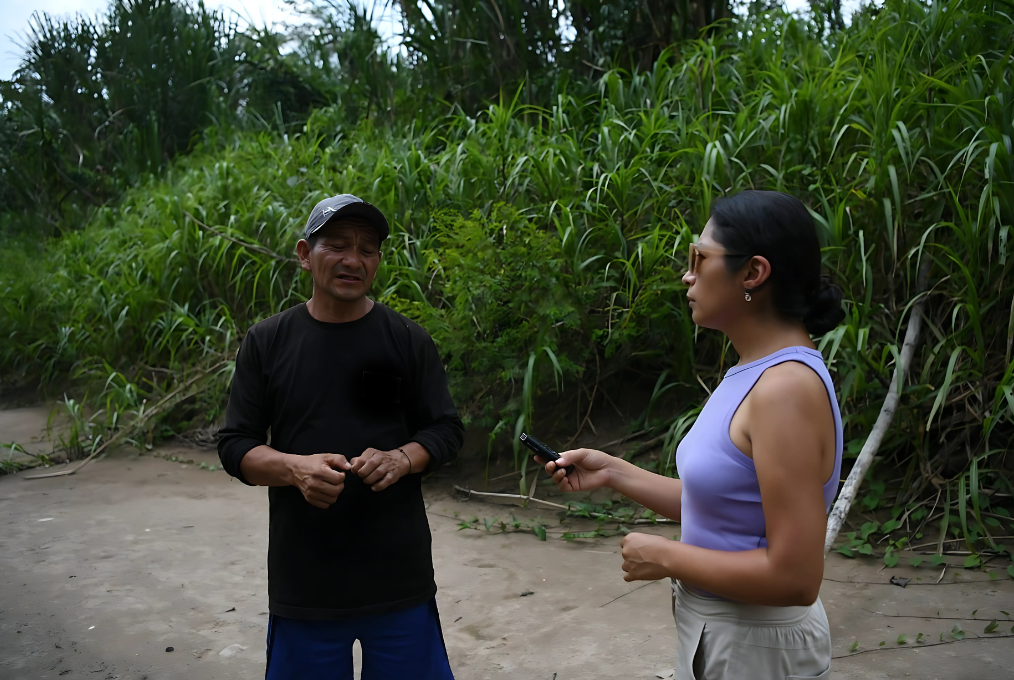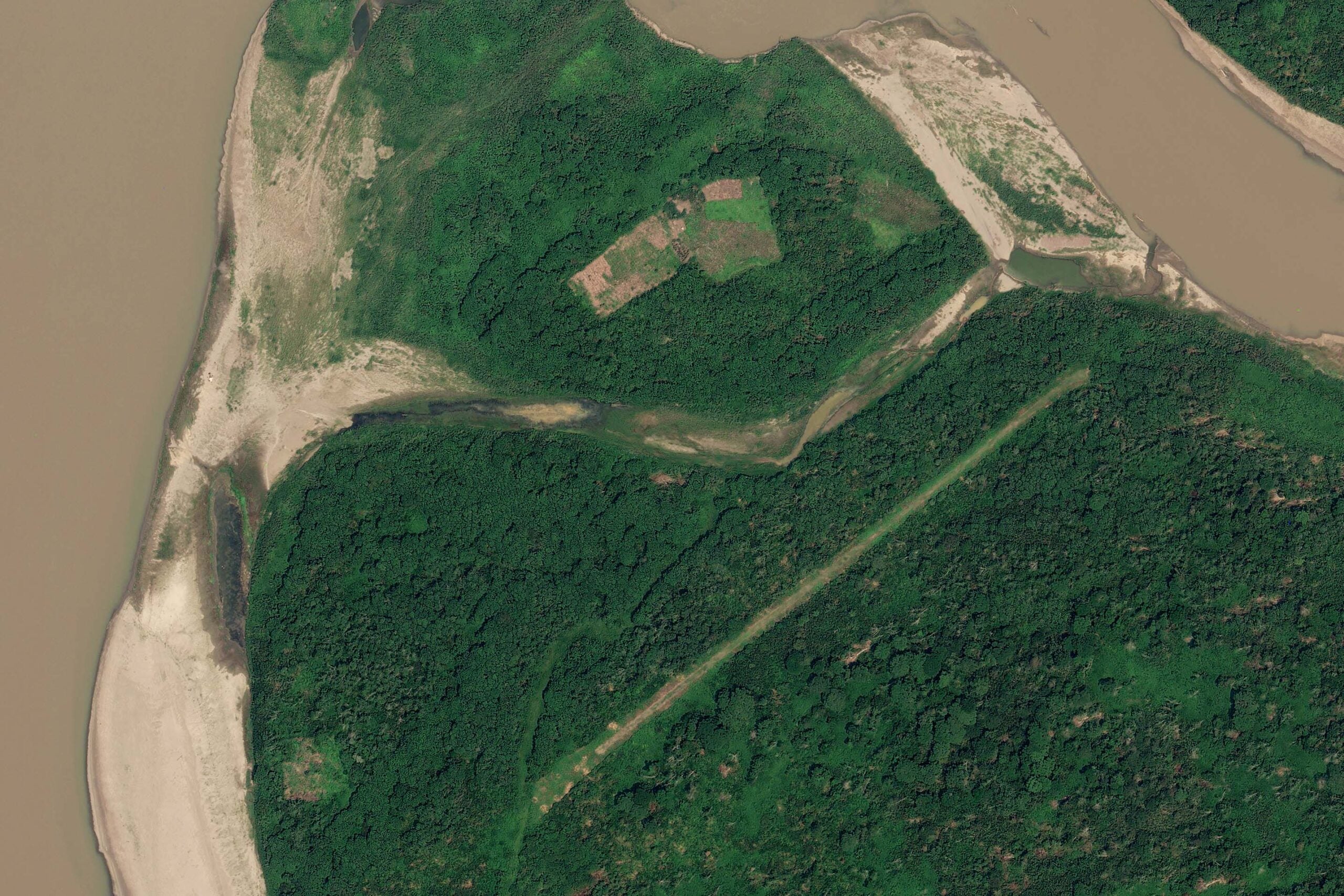Journalist Elizabeth Salazar arrived at an isolated Indigenous community of the Kakataibo ethnic group in the heart of the Peruvian Amazon one night in 2024 to investigate how the existence of clandestine organized crime airstrips was altering people's lives. Accompanied by a fellow photographer, Salazar approached the only street food stall she could find in search of something to eat.
Suddenly, the silence and darkness of the town were abruptly broken by the violent noise and psychedelic lights of a motorcycle speeding toward them. The journalist immediately sensed something was out of place. That motorcycle didn't fit with the reality of an Indigenous community.
“It was a vehicle that wasn't from the area and was very conspicuous, enough to stand out,” she thought, interpreting it as a message from someone wanting to say, “We know you're here.”

Elizabeth Salazar was one of the reporters who did field reporting in the Peruvian Amazon for the project “Los vuelos de la muerte”, finalist for the Gabo Award 2025. (Photo: Courtesy Elizabeth Salazar)
As the days passed, Salazar managed to blend in with the locals and witness how the social dynamics of the Indigenous community were changing with the arrival of customs alien to it, such as a beauty pageant for teenagers in high heels and scantily clad clothing, which Salazar witnessed.
These are just a few of the many experiences experienced by reporters participating in “Los vuelos de la muerte” (Death Flights), an investigation by the environmental journalism organization Mongabay Latam.
The investigation, a finalist for the 2025 Gabo Award in te Coverage Category, consists of five reports and an interactive map detailing the discovery of 67 clandestine airstrips attributed to drug trafficking in areas of increasing violence against Indigenous leaders in the Peruvian Amazon. The investigation determined that the narco-airstrips are located in "hotspots" within the Amazon region where illicit crops, deforestation and logging concessions converge.
But Mongabay Latam didn’t leave the investigation to the computer screen. With the aim of breaking the mold of traditional journalism, it’s bringing the stories to the stage. The media outlet will share its findings with other audiences through a narrative capable of emotionally engaging viewers and raising awareness about the issue of violence against Indigenous communities in the Amazon.
“The intention is to place the audience in the theater in the same moment and state of mind I was in when I entered that community. That feeling, which isn't always experienced by the reader when described in a text, is very powerful in theater,” Salazar told LatAm Journalism Review (LJR). “These types of scenes can help the audience understand something that's happening in our jungle.”
Rutas del Conflicto, a Colombian media outlet specializing in reporting on the armed conflict and historical memory, started staging what it calls "stand-up journalism" performances three years ago in partnership with Mongabay Latam. Since then, the two outlets have created five productions based on joint investigations into environmental issues in Colombia, said Óscar Parra, director of Rutas del Conflicto.
Although the Colombian organization did not participate in the production of the "Death Flights" stories, Parra is advising the Mongabay Latam team in Peru on adapting the investigation into stand-up journalism. This will be the first production in that format outside Colombia, Parra said.
“We think it's innovative and a way to build community to have the opportunity to speak directly to the audience and tell them what happened,” Parra told LJR. “There are a lot of anecdotal situations that occur when you do these investigations that aren't normally written down in the texts.”
For the Peruvian team at Mongabay Latam, stand-up journalism is a great opportunity to showcase their investigative findings to a segment of the public that doesn't normally consume long-form reports.
“That's one of the blessings of this form of communication, theater. You have an audience willing to watch and listen,” Salazar said. “They're sitting, all looking at the same point, with the intention of putting all their focus, eyes and ears on the problem you’ve come to tell them about. It's very different in digital or multimedia formats, where you compete for attention with your surroundings.”
Parra said the idea of adapting journalistic investigations to theatrical format arose when, in 2019, he witnessed a series of short Broadway productions in New York in which journalists discussed and showed footage about how they had conducted an investigative report.
Parra thought this would be an innovative way to directly present the Rutas del Conflicto investigations to the public. However, he felt it was missing something compelling. So he thought showing behind-the-scenes footage of the reporting might spark more interest in the stories.
“We tell what happens to us so that people can laugh a little at our circumstances as journalists, but at the same time, people will always remember the critical situation the community [covered in the reports] is experiencing,” Parra said.
¡Gracias por acompañarnos en nuestra primera función de este ciclo de Stand Ups Periodístico!
Gracias de nuevo a nuestros colaboradores @BoellColombia y @MongabayLatam por apostarle a esta nueva manera de contar historias pic.twitter.com/JVUCysxRlh
— Rutas del Conflicto (@RutasConflicto) June 21, 2024
In the Rutas del Conflicto stand-up shows, one or more journalists share behind-the-scenes details of an investigation for about an hour and a half, set against a simple backdrop, while photographs, documents and video testimonies from the subjects of their stories are shown on screen.
“We use the anecdotes the journalists experienced as a narrative thread within these spaces,” Parra said. “The format lends itself to interactions with the audience that wouldn't be possible with traditional journalism.”
Alexa Vélez, editor in chief of Mongabay Latam, said that the stand-up journalism performance for "Death Flights" will include two reporters who will share their experiences on the ground and an editor who will explain how the database that led to the reports was created and how the artificial intelligence tool that detected the narco-airstrips worked. This tool was developed by Earth Genome, a U.S. organization that specializes in technology and data about the planet.
Mongabay Latam also hopes to bring on stage an Indigenous leader from one of the communities where the reporting was done, Vélez added.
“We journalists are always looking for new ways to keep people informed and interested in these issues,” Vélez told LJR. “There are many stories about things that happened in the field that I think are very relevant and also very interesting for people to connect with.”
The journalist emphasized that, to date, in addition to the Gabo Award nomination and selection as finalist, "Death Flights" has had a significant impact, including coverage and republishing in major media outlets in Peru and Latin America, an article on the investigation in The Wall Street Journal, and a place among the investigative projects shortlisted for the 2025 Global Shining Light Awards from the Global Investigative Journalism Network (GIJN).
However, Vélez said that there remains a lack of sensitivity and interest in the problems of the Amazon among Peruvian society and government. Therefore, Mongabay Latam hopes that the stand-up journalism will help further disseminate the discoveries of "Death Flights.”
"There's no awareness of this issue from either the audience or the authorities. It's an attempt to provide another element that will stir up the issue and achieve greater impact and visibility," Vélez said.
Salazar said it's very difficult for journalism to convey these types of stories to audiences who are unfamiliar with what it's like to be in the Amazon and with how Indigenous communities live in hostile environments. The theatrical adaptations by Mongabay and Rutas del Conflicto also aim to combat the stereotypes, prejudices and misconceptions that arise from this lack of knowledge, she added.

“Los vuelos de la muerte” revealed the existence of 67 clandestine airstrips in areas of high violence against indigenous leaders in the Peruvian Amazon. (Photo: Courtesy of Mongabay Latam)
“The experiences that happen in the field sometimes make the story more interesting, so the audience can better understand what it's like to be close to that territory,” Salazar said. “I think theater raises awareness about this type of coverage, especially among those who have never even set foot in the Amazon.”
To help the audience better understand contextual elements such as distances in the jungle, laws, technical terms or the geographic isolation of Amazonian communities, stand-up journalism includes educational elements in the form of question-and-answer games with viewers.
In the case of "Death Flights," these interactive games will serve to explain how the presence of criminal groups manifests itself in the Peruvian Amazon and how the artificial intelligence tool that located the narco-airstrips works, Parra said.
“We invented games similar to ‘Who Wants to Be a Millionaire’ to play with the audience and try to explain the more complicated elements of the context,” Parra said. “The important thing here is that people understand the seriousness of the existence of these airstrips in the middle of their ancestral lands for Indigenous communities.”
Parra explained that the stand-up journalism shows they've produced in collaboration with Mongabay Latam have received support from funding organizations that cover production costs, allowing them to offer a number of agreed-upon performances for free. However, they've also offered performances for which the audience pays an entrance fee.
This, the journalist said, opens up a new financing opportunity for the media involved.
“Unfortunately, no one is paying for journalism,” Parra said. "Basically, what we also have with the [stand-up] audience is a space to offer an experience so they can come and listen to journalism. And people do pay for that experience.”